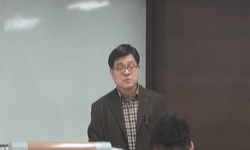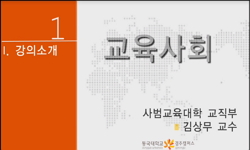Ryu Su-Won(柳壽垣)'s 『Wuseo(迂書)』 is a book that suggests the reformation on the problems of the time by insight into the late Joseon Dynasty. The beginning comes from the discussion of educational reformation and selecting talent. As a resu...
http://chineseinput.net/에서 pinyin(병음)방식으로 중국어를 변환할 수 있습니다.
변환된 중국어를 복사하여 사용하시면 됩니다.
- 中文 을 입력하시려면 zhongwen을 입력하시고 space를누르시면됩니다.
- 北京 을 입력하시려면 beijing을 입력하시고 space를 누르시면 됩니다.

조선 후기 정치사회상과 농암 류수원의 인재등용론 = Ryu Su-Won's discussion about selecting talent in the late of Joseon Dynasty's political society
한글로보기부가정보
다국어 초록 (Multilingual Abstract)
Based on Ryu Su-Won's 『Wuseo』, the summary of problems in education and selecting talent in the late Joseon Dynasty is as follows. First, each educational institution in the late Joseon Dynasty had more confucian students than the capacity. This had resulted in national losses of military services and even lack of proper education. In addition, Confucian student's Memorial to the King(儒疏), which was regarded as the right of the confucian students, was connected as a means of party strife, and the students tended to concentrate more on politics than on academics. On the other hand, the selection function of talent through the civil service examinations was monopolized exclusively by several noble lineage. It seems the cheating was prevalent in the civil service examinations.
Ryu Su-Won has made the following arguments regarding those problems. First of all, he tried to solve the problem of over capacity in educational institution by setting up a system of Bu-student(附學生). This seems to be a more realistic approach than the claim to limit the number of confucian students and to mobilize the students who exceeded the capacity, to military services. Ryu Su-Won also opposed political participation of the confucian students and denied the act of Confucian student's Memorial to the King itself. This is a different point from the social conditions of accepting Confucian student's Memorial to the King in the bureaucracy of the time. Meanwhile, Ryu Su-Won has severely criticized the harmful effect of the noble lineage and insisted that talent to be selected by fair examinations. Here, it can be confirmed that the flexibility that pressed awakening of noble lineage's children under the agreement in the value of existence of Sadaebu, and the significance of detailed defining the enforcement rules to block out the cheating in the civil service examinations beforehand, and etc.
Ryu Su-Won(柳壽垣)'s 『Wuseo(迂書)』 is a book that suggests the reformation on the problems of the time by insight into the late Joseon Dynasty. The beginning comes from the discussion of educational reformation and selecting talent. As a result, the researches on Ryu Su-Won's educational reformation theory was steadily progressed and some achievements were accumulated. However, the researches so far are mainly based on the results analyzed in the framework of 『Wuseo』 grounded on the educational perspective. This paper paid attention to the fact that the discussion of Ryu Su-Won was triggered in the political society of the time, and tried to find out the meaning of the discussion about education and selecting talent in the 『Wuseo』 compared with the arguments of his contemporaries.
Based on Ryu Su-Won's 『Wuseo』, the summary of problems in education and selecting talent in the late Joseon Dynasty is as follows. First, each educational institution in the late Joseon Dynasty had more confucian students than the capacity. This had resulted in national losses of military services and even lack of proper education. In addition, Confucian student's Memorial to the King(儒疏), which was regarded as the right of the confucian students, was connected as a means of party strife, and the students tended to concentrate more on politics than on academics. On the other hand, the selection function of talent through the civil service examinations was monopolized exclusively by several noble lineage. It seems the cheating was prevalent in the civil service examinations.
Ryu Su-Won has made the following arguments regarding those problems. First of all, he tried to solve the problem of over capacity in educational institution by setting up a system of Bu-student(附學生). This seems to be a more realistic approach than the claim to limit the number of confucian students and to mobilize the students who exceeded the capacity, to military services. Ryu Su-Won also opposed political participation of the confucian students and denied the act of Confucian student's Memorial to the King itself. This is a different point from the social conditions of accepting Confucian student's Memorial to the King in the bureaucracy of the time. Meanwhile, Ryu Su-Won has severely criticized the harmful effect of the noble lineage and insisted that talent to be selected by fair examinations. Here, it can be confirmed that the flexibility that pressed awakening of noble lineage's children under the agreement in the value of existence of Sadaebu, and the significance of detailed defining the enforcement rules to block out the cheating in the civil service examinations beforehand, and etc.
국문 초록 (Abstract)
류수원의 『우서』에 근거하여 요약한 조선 후기 교육 및 인재등용의 문제점은 다음과 같다. 먼저 조선 후기 각 교육기관에는 정원보다 많은 유생이 넘쳐났는데 이는 국가적으로 군역의 손실을 불러오고 적절한 교육마저 시행되지 못하는 결과를 초래했다. 또한 유생의 권리로 여겨지던 儒疏는 당쟁의 수단과 결부되며 유생들은 학문보다 정치에 몰두하는 경향을 보였다. 한편 과거시험을 통한 인재의 선발기능은 몇몇 문벌에 의한 전유물로 독점되었고 그나마 유지되던 시험도 부정행위 등이 만연한 상황이었던 것으로 보인다.
류수원은 이러한 문제점에 대해 다음과 같은 주장을 개진했다. 먼저 附學生 제도를 두어 정원초과의 폐해를 해결하고자 했다. 이는 무조건 정원을 한정하고 額外 유생들을 군역에 동원해야 한다는 주장에 비해 적용 가능한 현실적 방안이라 생각된다. 또한 류수원은 유생의 정치참여를 반대하며 유소의 행위 자체를 부정했다. 이는 당시 관료사회에서 유소를 인정하던 세태와 차별화된 지점이다. 한편 류수원은 문벌의 폐해를 엄격하게 비판했고, 공정한 시험으로 인재가 선발되어야 한다고 주장했다. 여기서는 사대부의 존재 가치를 인정하며 문벌가 자제들의 각성을 촉구한 유연성이 나타나고, 과거시험의 부정을 사전에 차단하도록 시행규칙을 세세하게 규정한 의의 등을 확인할 수 있다.
柳壽垣의 『迂書』는 조선 후기 시대상을 통찰하여 당대 문제점의 개혁안을 제시한 저술이다. 그 시작은 교육개혁과 인재등용에 대한 논의에서 비롯된다. 이로 인해 류수원의 교육개혁론에...
柳壽垣의 『迂書』는 조선 후기 시대상을 통찰하여 당대 문제점의 개혁안을 제시한 저술이다. 그 시작은 교육개혁과 인재등용에 대한 논의에서 비롯된다. 이로 인해 류수원의 교육개혁론에 대한 연구가 꾸준히 진행되면서 성과도 어느 정도 축적되었다. 다만 그동안의 연구는 주로 교육학적 시각에 입각하여 『우서』라는 틀 안에서 분석된 연구결과가 주를 이룬다. 이 글에서는 류수원의 논의가 당대 정치사회상에서 촉발되었음에 주목하여 동시대 인물들의 주장과 비교해 『우서』에 나타난 교육과 인재등용에 대한 논의의 의미를 알아보고자 했다.
류수원의 『우서』에 근거하여 요약한 조선 후기 교육 및 인재등용의 문제점은 다음과 같다. 먼저 조선 후기 각 교육기관에는 정원보다 많은 유생이 넘쳐났는데 이는 국가적으로 군역의 손실을 불러오고 적절한 교육마저 시행되지 못하는 결과를 초래했다. 또한 유생의 권리로 여겨지던 儒疏는 당쟁의 수단과 결부되며 유생들은 학문보다 정치에 몰두하는 경향을 보였다. 한편 과거시험을 통한 인재의 선발기능은 몇몇 문벌에 의한 전유물로 독점되었고 그나마 유지되던 시험도 부정행위 등이 만연한 상황이었던 것으로 보인다.
류수원은 이러한 문제점에 대해 다음과 같은 주장을 개진했다. 먼저 附學生 제도를 두어 정원초과의 폐해를 해결하고자 했다. 이는 무조건 정원을 한정하고 額外 유생들을 군역에 동원해야 한다는 주장에 비해 적용 가능한 현실적 방안이라 생각된다. 또한 류수원은 유생의 정치참여를 반대하며 유소의 행위 자체를 부정했다. 이는 당시 관료사회에서 유소를 인정하던 세태와 차별화된 지점이다. 한편 류수원은 문벌의 폐해를 엄격하게 비판했고, 공정한 시험으로 인재가 선발되어야 한다고 주장했다. 여기서는 사대부의 존재 가치를 인정하며 문벌가 자제들의 각성을 촉구한 유연성이 나타나고, 과거시험의 부정을 사전에 차단하도록 시행규칙을 세세하게 규정한 의의 등을 확인할 수 있다.
참고문헌 (Reference)
1 최식, "李憲明이 바라본 沆瀣洪吉周" 동양한문학회 21 : 2005
2 姜永範, "柳壽垣의 敎育과 官吏任用制度改善論" 國民大學校 敎育大學院 1990
3 정명기, "聾菴柳壽垣의 敎育論硏究" 부산대학교 1988
4 張惠子, "聾菴 柳壽垣의 科擧制 改善論" 釜山大學校 敎育大學院 1991
5 차미희, "조선후기 숙종대 壬辰科獄 연구" 민족문화연구원 (42) : 269-305, 2005
6 김은하, "조선후기 북학파 유수원과 홍대용의 교육개혁론" 전남대학교 교육대학원 2010
7 심노숭, "자저실기 : 글쓰기 병에 걸린 어느 선비의 일상" 휴머니스트 2014
8 김세호, "이민서․이건명 父子의 선유도 별서" 문헌과해석사 (68) : 2014
9 최광만, "유수원의 교육개혁론" 교육사학회 23 (23): 21-49, 2013
10 정순우, "농암유수원 연구" 사람의무늬 2014
1 최식, "李憲明이 바라본 沆瀣洪吉周" 동양한문학회 21 : 2005
2 姜永範, "柳壽垣의 敎育과 官吏任用制度改善論" 國民大學校 敎育大學院 1990
3 정명기, "聾菴柳壽垣의 敎育論硏究" 부산대학교 1988
4 張惠子, "聾菴 柳壽垣의 科擧制 改善論" 釜山大學校 敎育大學院 1991
5 차미희, "조선후기 숙종대 壬辰科獄 연구" 민족문화연구원 (42) : 269-305, 2005
6 김은하, "조선후기 북학파 유수원과 홍대용의 교육개혁론" 전남대학교 교육대학원 2010
7 심노숭, "자저실기 : 글쓰기 병에 걸린 어느 선비의 일상" 휴머니스트 2014
8 김세호, "이민서․이건명 父子의 선유도 별서" 문헌과해석사 (68) : 2014
9 최광만, "유수원의 교육개혁론" 교육사학회 23 (23): 21-49, 2013
10 정순우, "농암유수원 연구" 사람의무늬 2014
11 허남태, "농암 유수원의 교육사상 연구" 강원대학교 교육대학원 2001
12 이은주, "聾菴柳壽垣의 學校制度改革案硏究" 인하대학교 1986
13 권은경, "柳壽垣의 學制.科擧制論硏究" 연세대학교 1994
14 차장섭, "朝鮮後期의 門閥; 增補文獻備考氏族考의 分析" 2 : 1993
15 윤희면, "朝鮮後期額內校生" 서강대학교 동아연구소 13 : 1988
16 尹熙勉, "朝鮮後期 鄕校 硏究" 西江大學校 大學院 1989
17 양기정, "『禮記類編』의 毁板과 火書에 관한 연구" 한국고전번역원 39 (39): 207-240, 2012
18 김윤조, "19세기 견문지식의 축적과 지식의 탄생 : 지수염필" 소명출판 2013
동일학술지(권/호) 다른 논문
-
貞山 李秉休(1710∼1776)의 학문관과 천문역산학 담론
- 한국실학학회
- 구만옥
- 2019
- KCI등재
-
『우서』에 나타난 화폐유통론의 성격 -화폐와 상점의 운영을 중심으로
- 한국실학학회
- 유현재
- 2019
- KCI등재
-
- 한국실학학회
- 이선아
- 2019
- KCI등재
-
조선후기의 ‘封建’ 讀法에 대한 試論 -畿內의 통치방식에 대한 이해를 중심으로
- 한국실학학회
- 윤석호
- 2019
- KCI등재
분석정보
인용정보 인용지수 설명보기
학술지 이력
| 연월일 | 이력구분 | 이력상세 | 등재구분 |
|---|---|---|---|
| 2026 | 평가예정 | 재인증평가 신청대상 (재인증) | |
| 2020-01-01 | 평가 | 등재학술지 유지 (재인증) |  |
| 2017-01-01 | 평가 | 등재학술지 유지 (계속평가) |  |
| 2013-01-01 | 평가 | 등재학술지 유지 (등재유지) |  |
| 2010-01-01 | 평가 | 등재학술지 유지 (등재유지) |  |
| 2007-01-01 | 평가 | 등재학술지 선정 (등재후보2차) |  |
| 2006-01-01 | 평가 | 등재후보 1차 PASS (등재후보1차) |  |
| 2004-07-01 | 평가 | 등재후보학술지 선정 (신규평가) |  |
학술지 인용정보
| 기준연도 | WOS-KCI 통합IF(2년) | KCIF(2년) | KCIF(3년) |
|---|---|---|---|
| 2016 | 0.77 | 0.77 | 0.56 |
| KCIF(4년) | KCIF(5년) | 중심성지수(3년) | 즉시성지수 |
| 0.65 | 0.66 | 1.558 | 0.04 |




 KISS
KISS





